KITES
Kites come in a variety of shapes, sizes and designs. Regional influences, rider tastes, rider needs and budget are all determining factors in the choices that people make when choosing what kite they fly in winter. Here we will describe the various types of kite most commonly seen here and their respective advantages and disadvantages.
Kite Design Types
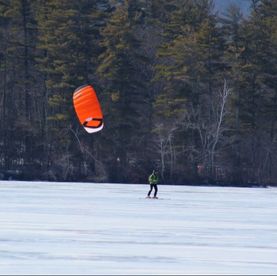
Dual Skin Foil kites
Dual Skin, also known as Ram Air kites or Foil kites, are one of the most commonly used kite type used by the most dedicated kite skiers.
They come in a variety of designs from "Open Cell" to "Closed Cell" to "Single Skin" and a few in between. Foil kites are characterized by their "parachute" like appearance, intakes (vents)in the leading (front) edge and bridles (strings) that support the kite's shape and have a somewhat "bumpy" aka "Air Mattress" appearance due to the individual cells.
Dual skins can be equipped with "closed cells" meaning that it has the ability to be used on water and won't immediately take water into the intakes. This makes for a great option if you are a year round rider wanting to ride water, but don't want the expense of two dedicated kite quivers.
Once the most popular snowkite type, they are losing ground to the new single skin types due to cost, durabilty and ease of use. However they arew still in favor with kiters looking for more perfomance than a single skin can offer.
Dual Skin, also known as Ram Air kites or Foil kites, are one of the most commonly used kite type used by the most dedicated kite skiers.
They come in a variety of designs from "Open Cell" to "Closed Cell" to "Single Skin" and a few in between. Foil kites are characterized by their "parachute" like appearance, intakes (vents)in the leading (front) edge and bridles (strings) that support the kite's shape and have a somewhat "bumpy" aka "Air Mattress" appearance due to the individual cells.
Dual skins can be equipped with "closed cells" meaning that it has the ability to be used on water and won't immediately take water into the intakes. This makes for a great option if you are a year round rider wanting to ride water, but don't want the expense of two dedicated kite quivers.
Once the most popular snowkite type, they are losing ground to the new single skin types due to cost, durabilty and ease of use. However they arew still in favor with kiters looking for more perfomance than a single skin can offer.
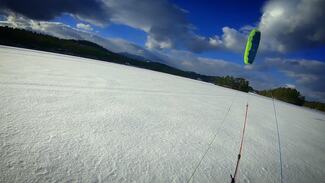
Single Skin Foil Kites.
Single skins are essentially a foil kite but without cells due to the lack of lower skin (Intrados) on the wing. The result is a kite that is lighter and impervious to over pressure damage than can occur when crashing a dual skin kite leading edge down. Single skins tend to have more power per size and are intended mostly for touring purposes in addition to being ultra compact so its easy to carry more than one on a tour. The flight quality is generally very good but do to their nature they aren't as "smooth" as a dual skin though that has improved greatly in the last 8 years.
They are fun, forgiving an even water relaunchable. They have an amazing amount of "drift" (float without being powered by the wind) which is a benefit when riding downhill after a climb, when you fly into lulls or when riding surf especially on a foil board.
Single skins are essentially a foil kite but without cells due to the lack of lower skin (Intrados) on the wing. The result is a kite that is lighter and impervious to over pressure damage than can occur when crashing a dual skin kite leading edge down. Single skins tend to have more power per size and are intended mostly for touring purposes in addition to being ultra compact so its easy to carry more than one on a tour. The flight quality is generally very good but do to their nature they aren't as "smooth" as a dual skin though that has improved greatly in the last 8 years.
They are fun, forgiving an even water relaunchable. They have an amazing amount of "drift" (float without being powered by the wind) which is a benefit when riding downhill after a climb, when you fly into lulls or when riding surf especially on a foil board.
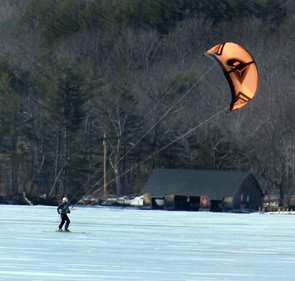
LEI Kites (Leading Edge Inflatable kites) tend to be "C" shaped, have rigid air filled "Struts" that support the shape of the wing and no bridles. These are the most common kite you see on the water and they are best suited for that use.
They require pumps to inflate the frame and get the kite into it's required shape to fly. As many of the components for this are plastic and inteded to be used in warmer conditions, this can be problematic in the cold. They also have bladders that support the rigid structure while inflated that can leak.
They have minimal bridles or sometimes none at all which a lot of people prefer and they hold their shape well in shifty winds and generally are simpler to fly than some foils.
They have a smooth appearance due to the lack of individual cells.
They require pumps to inflate the frame and get the kite into it's required shape to fly. As many of the components for this are plastic and inteded to be used in warmer conditions, this can be problematic in the cold. They also have bladders that support the rigid structure while inflated that can leak.
They have minimal bridles or sometimes none at all which a lot of people prefer and they hold their shape well in shifty winds and generally are simpler to fly than some foils.
They have a smooth appearance due to the lack of individual cells.
Snowkite Disciplines.
Touring, Freeride and Race
What are the differences?
Below are some brief definitions of different kite types and their intended uses.
Touring, Freeride and Race
What are the differences?
Below are some brief definitions of different kite types and their intended uses.
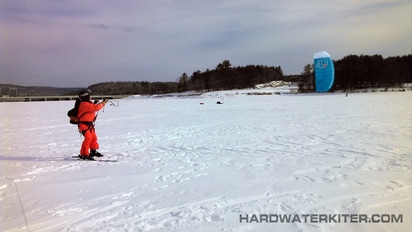
Touring.
Touring kites are generally the most user friendly. They are often regarded as "beginner" kites do to their forgiving nature but they aren't strictly beginner kites. They offer an amazing amount of performance in what they are designed to do.
They tend to be low aspect (Square shape and fatter) and are designed to handle gusty conditions. Some that are more beginner focused may have slightly slower turn rate than their higher performance counterparts as a means of restricting the risk of pilot error resulting in fast turn rate and accidental bursts of power. But some can be made to turn at nearly stunt kite performance while avoiding spikes in power. A handy feature for flying in tight areas.
Another key feature is low lift ability. They are not generally good jumping kites. This is to allow the kite to be flown in gusty conditions often found when kiting inland and touring and to reduce the risk of lofting. (being lifted off the surface accidentally). Again, this combined with slower turn rate, minimizes accidental lofting of beginners as they learn their kite placement skills or lofting at ridgelines or compressive wind at tree line.
Touring kites also tend to be very compact and light. To allow one to carry multiple wings in a pack and swap out as needed on long trips where the wind ranges or surface conditions may change beyond the usefulness of the kite that you started the day on. They also generate a lot of "grunt" or raw pulling power. Excellent for being pulled up hill. For expert riders on snow/ice this grunt can be translated into fast rates of forward speed. Some of the fastest kiters on the planet have gotten their best speeds on touring kites.
Examples of touring kites: Ozone Explore V2, HQ Apex, Flysurfer Peak 5
Touring kites are generally the most user friendly. They are often regarded as "beginner" kites do to their forgiving nature but they aren't strictly beginner kites. They offer an amazing amount of performance in what they are designed to do.
They tend to be low aspect (Square shape and fatter) and are designed to handle gusty conditions. Some that are more beginner focused may have slightly slower turn rate than their higher performance counterparts as a means of restricting the risk of pilot error resulting in fast turn rate and accidental bursts of power. But some can be made to turn at nearly stunt kite performance while avoiding spikes in power. A handy feature for flying in tight areas.
Another key feature is low lift ability. They are not generally good jumping kites. This is to allow the kite to be flown in gusty conditions often found when kiting inland and touring and to reduce the risk of lofting. (being lifted off the surface accidentally). Again, this combined with slower turn rate, minimizes accidental lofting of beginners as they learn their kite placement skills or lofting at ridgelines or compressive wind at tree line.
Touring kites also tend to be very compact and light. To allow one to carry multiple wings in a pack and swap out as needed on long trips where the wind ranges or surface conditions may change beyond the usefulness of the kite that you started the day on. They also generate a lot of "grunt" or raw pulling power. Excellent for being pulled up hill. For expert riders on snow/ice this grunt can be translated into fast rates of forward speed. Some of the fastest kiters on the planet have gotten their best speeds on touring kites.
Examples of touring kites: Ozone Explore V2, HQ Apex, Flysurfer Peak 5
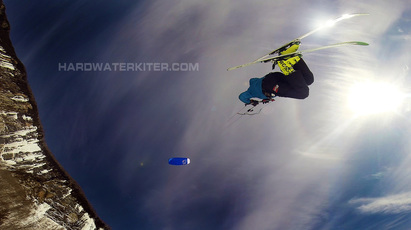
Freeride.
Freeride kites can be less user friendly to new riders and less forgiving in gusty conditions but offer more of a sporty feel and broader performance range. They tend to require more pilot input to fly smoothly in gusty conditions though over the last 7 years they have gotten much better.
They are faster turning and generate a lot of power in a turn. They are also more lifty and will lift aggressively when asked. This is often referred to as "pop". This said they will also lift aggressively when you don't want them to. So pilot experience is key to one's safety on these kites. They are slightly higher aspect (more rectangular and thinner) which adds to the kite's speed and the ability to go upwind.
They tend to be somewhat less stable than you average touring touring kite as turn rate and maneuverability are more important for freeride handling.
Examples of Freeride kites: Ozone Sub Zero, Flysurfer Soul
Freeride kites can be less user friendly to new riders and less forgiving in gusty conditions but offer more of a sporty feel and broader performance range. They tend to require more pilot input to fly smoothly in gusty conditions though over the last 7 years they have gotten much better.
They are faster turning and generate a lot of power in a turn. They are also more lifty and will lift aggressively when asked. This is often referred to as "pop". This said they will also lift aggressively when you don't want them to. So pilot experience is key to one's safety on these kites. They are slightly higher aspect (more rectangular and thinner) which adds to the kite's speed and the ability to go upwind.
They tend to be somewhat less stable than you average touring touring kite as turn rate and maneuverability are more important for freeride handling.
Examples of Freeride kites: Ozone Sub Zero, Flysurfer Soul
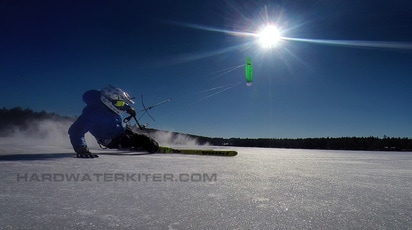
Race.
Race kites are a breed of their own compared to Tour and Freestyle kites which share a lot of similar traits and appearance. Race kites are the thoroughbreds of the kiting world. They are designed to off the ultimate in efficiency and performance. As such they also demand the best in terms of pilot skill. Compared to the other kites we've listed above they then to be harder to launch, messy to deal with if you have to activate your safety system, and less forgiving in gusty conditions requiring heavy pilot input to manage gust factor. Though most current race wings are actually fairly user friendly.
Race kites are ultra high aspect. Generally with an AR of 7 and up. Thin and long, they often looking like a straight razor in the air. It takes a bit of foil kite experience to really get the most out of what these kites have to offer. If you have the skills required or take the time to learn to make the most of these kites, they are amazing in what they do. The go nearly straight upwind, and the larger sizes, even in standard weight fabric, fly in much less wind than the non-race variants out there.
Race Kites use race specific bar systems. They tend to be 4 line low V with extra bar throw and extra trim on a two pully system that enables you to easily fine adjust the trim under power without off weighting to reach the trim line. We often see people on race wings without a race type bar and getting only some of the performance that a race kite has to offer.
They do not fly like LEIs and if you try to fly them the same way you will have a hard time getting the performance that they can provide. However, even a poorly handled kite like this will out perform an LEI in some conditions.
Race kites are ultra high performance and high demand kites. But they are a thrill to fly. The are relatively slow turners and slow jumpers (compared to a lower AR freestyle kite) as a result. But with experience they can be extremely nimble and precise and they will glide for days when you do actually jump them. Flysurfer Sonic and Ozone Chrono V4 are user friendly race variants.
Some basic things to consider when deciding which kite works for you.
Kite Sizing, Power per size.
Kite size depends primarily on what you weigh, what winds you tend to ride in and what you have on your feet. A kite on land is going to offer very different power than a kite on water. Even the difference between skis and a snowboard can affect the sizing as snowboarders need more power than skiers.
Foils have a flatter profile in the wing (canopy) than which allows them to have more Projected Area (PA) compared to Arcs and Leading Edge Inflatable kites. PA is the amount of wing that is actually doing the real work of producing power. For example, a 12m kite may have 12 square meters of fabric in the wing size but it's PA may only be 9-10 square meters due to the curvature of the wing. Projected area would be like the square meter of a kite's shadow when directly over head. This is not always the case however. In the case of Peter Lynn Arc foil types they tend to have fairly low PA for a given size due to their Arc shape, similar to a C type leading edge inflatable. So for example a 15m Arc may only have a PA of 9m square.
Note: Wind ranges can be a moving target in snow kiting. Between the cold effect on air density and the drag (or lack there of) on a snow surface, choosing the right size can be a challenge. For example often warm weather riders will throw the same size kite up in winter 12kt that they do in summer 12kts and have issues with being over powered because they didn't take friction and cold air density into consideration. Another consideration in some regions is altitude. Kites at sea level will act differently than kites at 10,000 feet.
If needed many kites generally can have their wind ranges altered by line length. Longer lines add power while shorter lines reduce power. This is done with the use of line extensions or by doubling the lines back and larks heading the middle. This is harder these days as many kites come with Front Line Safety (FLS) lines that are grafted into a flying line and are part of the safety system. The same goes for 5th line kites. The ability to shorten or lengthen lines out in the field or mid-tour is a handy way to reduce the number of kites you need in a given session or wind range. Additions of pigtails can make half-lining kites much easier.
Versatility and Where You Fly.
Foils have cells. Cells are the individual sections of the kite that are filled with air and give the wing it's shape.
"Open cell" types are designed strictly for use in dry environments and are not for use where they can fill with water.
"Closed cell" foils have "valves" that can keep water from entering the leading edge of the kite and causing it to sink.
This allows the use of the foil on both hard and soft water. In other words they double very well as kite surf kites and offer the best of both worlds. The drawback is that they are not as nimble as a a purpose built LEI and if the kite is in the water for extended time, it will start to sink. Unlike an water specific LEI.
LEI's are designed to be used primarily on water. As such they ten to be more user friendly on water and in some ways arguably safer as even though closed cell foils can be re-launched off water , they tend to be somewhat more difficult than LEIs and even closed cells can fill with water and become an swamped as opposed to LEIs which are sealed air filled units.
The weakness of LEI's on snow/ice is the cold and bulk. Newer LEIs are more durable in the cold than they used to be but still plastic valves and bladders get less easy to manage in sub zero temps and crashing a kite made of pressurized air filled bladders into the ice can have bad results that foils rarely have to consider.
Additionally they don't pack down as well and they weigh more. Adding in the required pump, they are unsuitable for snowkiting beyond short term riding.
This doesn't mean that LEI's can't be used for snow use, just not ideal. Just like foils, even closed cells aren't really ideal for use on water.
The biggest advantage LEI kites have over most foils is the amount of depower they offer. The ability to completely stop pulling when the bar is pushed away. Especially SLE (supported leading edge) style LEIs. There are some foils for example the Gin Shaman and Ozone Access which come very close to SLE performance.
Set up and pack down.
Set up time of foils is fast. A single skin kite like the Flysurfer Peak 5 or 2015+ Ozone SubZero with the RE-Ride system, can bet set up and in the air in less than two minutes. LEI's need to be pumped up prior to being flown. Launching and landing foils is easily done without assistance whereas LEIS, especially on hard surfaces with minimal sliding resistance, can be more work. Swapping wings mid ride is difficult with LEIS, foils are easily carried and swapped.
Turn rate. Foils traditionally have always been slower turning than comparable LEI types. In some cases this is a pretty minor thing unless you are looking to perform certain freestyle maneuvers. Although the turn rate of most modern high performance freestyle foils is very close to LEI turn rate and some can turn as fast these days.
Luffing. In shifting or gusting winds, especially light winds, foil kites tend to deform and get pushed around at times where LEI with their rigid construction have the ability to withstand changes in wind speed and direction and can be positioned out of problem areas and moved to better air with a bit more grace. This said, experienced foil fliers understand a little situational awareness can help one recognize when things are going to go bad and counter it before things get too ugly.
Depower. In modern kites both types are very good in regards to depower. SLE type LEIs generally seem to have more depower than most foils but this is becoming less the case as foils become more advanced. For example the Flysurfer Peak single skin foil or Viron have essentially the same type of depower style of a modern SLE.
Ability to transport.
Foils can be packed down to fairly small size allowing a touring kiter to carry one or two back up wings in their pack in the event that the wind ranges on their tour change beyond the abilities of your kite to build or reduce the power needed to get back to your launch site. LEIs tend to be much bulkier, heavier and require pumps to inflate. Transport is less a consideration for the for some one who is looking to ride in a somewhat limited space than it is for snow kiter who has more ambitious riding in mind.
Cost. Foils tend to be more expensive than the comparable LEI. This is because they take more labor to produce and the demand for foils in general is lower compared to water use LEIs. However, foils tend to be more durable and last a lot longer than most LEIs and hold their value in the event you want to upgrade. If you are short on funds and want one kite to do it all and are primarily a water rider, an LEI is a good option as they can be had for less and used year round. If you want long term use and value, a foil is worth the initial investment. Especially a closed cell so you can ride water in the warmer months.
Again, this is a pretty broad general comparison. If you ask any dedicated kiter from either camp they will give you a list of why one type is better than another. And there are always a few zealots. Many opinions aren't based on experience but more on what one hears or reads. The thin and myopic views you might find in a kite surf magazine may not be the best source of info. It's a KITE SURF magazine, not SNOW KITE. And as much as many would like to think they are essentially the same, they are not.
In reality the is the pilot makes the kite, not the other way around.
There are very few "bad" kites and in general, the kites do only what they are told. More often than not the issue is piloting, not gear.
Kite Sizing, Power per size.
Kite size depends primarily on what you weigh, what winds you tend to ride in and what you have on your feet. A kite on land is going to offer very different power than a kite on water. Even the difference between skis and a snowboard can affect the sizing as snowboarders need more power than skiers.
Foils have a flatter profile in the wing (canopy) than which allows them to have more Projected Area (PA) compared to Arcs and Leading Edge Inflatable kites. PA is the amount of wing that is actually doing the real work of producing power. For example, a 12m kite may have 12 square meters of fabric in the wing size but it's PA may only be 9-10 square meters due to the curvature of the wing. Projected area would be like the square meter of a kite's shadow when directly over head. This is not always the case however. In the case of Peter Lynn Arc foil types they tend to have fairly low PA for a given size due to their Arc shape, similar to a C type leading edge inflatable. So for example a 15m Arc may only have a PA of 9m square.
Note: Wind ranges can be a moving target in snow kiting. Between the cold effect on air density and the drag (or lack there of) on a snow surface, choosing the right size can be a challenge. For example often warm weather riders will throw the same size kite up in winter 12kt that they do in summer 12kts and have issues with being over powered because they didn't take friction and cold air density into consideration. Another consideration in some regions is altitude. Kites at sea level will act differently than kites at 10,000 feet.
If needed many kites generally can have their wind ranges altered by line length. Longer lines add power while shorter lines reduce power. This is done with the use of line extensions or by doubling the lines back and larks heading the middle. This is harder these days as many kites come with Front Line Safety (FLS) lines that are grafted into a flying line and are part of the safety system. The same goes for 5th line kites. The ability to shorten or lengthen lines out in the field or mid-tour is a handy way to reduce the number of kites you need in a given session or wind range. Additions of pigtails can make half-lining kites much easier.
Versatility and Where You Fly.
Foils have cells. Cells are the individual sections of the kite that are filled with air and give the wing it's shape.
"Open cell" types are designed strictly for use in dry environments and are not for use where they can fill with water.
"Closed cell" foils have "valves" that can keep water from entering the leading edge of the kite and causing it to sink.
This allows the use of the foil on both hard and soft water. In other words they double very well as kite surf kites and offer the best of both worlds. The drawback is that they are not as nimble as a a purpose built LEI and if the kite is in the water for extended time, it will start to sink. Unlike an water specific LEI.
LEI's are designed to be used primarily on water. As such they ten to be more user friendly on water and in some ways arguably safer as even though closed cell foils can be re-launched off water , they tend to be somewhat more difficult than LEIs and even closed cells can fill with water and become an swamped as opposed to LEIs which are sealed air filled units.
The weakness of LEI's on snow/ice is the cold and bulk. Newer LEIs are more durable in the cold than they used to be but still plastic valves and bladders get less easy to manage in sub zero temps and crashing a kite made of pressurized air filled bladders into the ice can have bad results that foils rarely have to consider.
Additionally they don't pack down as well and they weigh more. Adding in the required pump, they are unsuitable for snowkiting beyond short term riding.
This doesn't mean that LEI's can't be used for snow use, just not ideal. Just like foils, even closed cells aren't really ideal for use on water.
The biggest advantage LEI kites have over most foils is the amount of depower they offer. The ability to completely stop pulling when the bar is pushed away. Especially SLE (supported leading edge) style LEIs. There are some foils for example the Gin Shaman and Ozone Access which come very close to SLE performance.
Set up and pack down.
Set up time of foils is fast. A single skin kite like the Flysurfer Peak 5 or 2015+ Ozone SubZero with the RE-Ride system, can bet set up and in the air in less than two minutes. LEI's need to be pumped up prior to being flown. Launching and landing foils is easily done without assistance whereas LEIS, especially on hard surfaces with minimal sliding resistance, can be more work. Swapping wings mid ride is difficult with LEIS, foils are easily carried and swapped.
Turn rate. Foils traditionally have always been slower turning than comparable LEI types. In some cases this is a pretty minor thing unless you are looking to perform certain freestyle maneuvers. Although the turn rate of most modern high performance freestyle foils is very close to LEI turn rate and some can turn as fast these days.
Luffing. In shifting or gusting winds, especially light winds, foil kites tend to deform and get pushed around at times where LEI with their rigid construction have the ability to withstand changes in wind speed and direction and can be positioned out of problem areas and moved to better air with a bit more grace. This said, experienced foil fliers understand a little situational awareness can help one recognize when things are going to go bad and counter it before things get too ugly.
Depower. In modern kites both types are very good in regards to depower. SLE type LEIs generally seem to have more depower than most foils but this is becoming less the case as foils become more advanced. For example the Flysurfer Peak single skin foil or Viron have essentially the same type of depower style of a modern SLE.
Ability to transport.
Foils can be packed down to fairly small size allowing a touring kiter to carry one or two back up wings in their pack in the event that the wind ranges on their tour change beyond the abilities of your kite to build or reduce the power needed to get back to your launch site. LEIs tend to be much bulkier, heavier and require pumps to inflate. Transport is less a consideration for the for some one who is looking to ride in a somewhat limited space than it is for snow kiter who has more ambitious riding in mind.
Cost. Foils tend to be more expensive than the comparable LEI. This is because they take more labor to produce and the demand for foils in general is lower compared to water use LEIs. However, foils tend to be more durable and last a lot longer than most LEIs and hold their value in the event you want to upgrade. If you are short on funds and want one kite to do it all and are primarily a water rider, an LEI is a good option as they can be had for less and used year round. If you want long term use and value, a foil is worth the initial investment. Especially a closed cell so you can ride water in the warmer months.
Again, this is a pretty broad general comparison. If you ask any dedicated kiter from either camp they will give you a list of why one type is better than another. And there are always a few zealots. Many opinions aren't based on experience but more on what one hears or reads. The thin and myopic views you might find in a kite surf magazine may not be the best source of info. It's a KITE SURF magazine, not SNOW KITE. And as much as many would like to think they are essentially the same, they are not.
In reality the is the pilot makes the kite, not the other way around.
There are very few "bad" kites and in general, the kites do only what they are told. More often than not the issue is piloting, not gear.
Harnesses
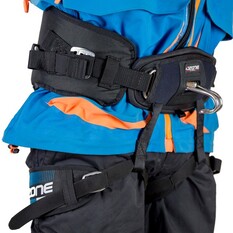 Ozone Connect Pro Harness
Ozone Connect Pro Harness
Harnesses come in two general types. Waist and seat. The most popular style of harness for water riding seems to be a waist harness. As the name indicates these harnesses are positioned around your waist/low torso. While for water riding this may be functional, trying to get the same harness to work the same way over your winter clothing can be problematic. It can be hard to get the harness to fit correctly and snug up with layers of ski clothing underneath. Also having the harness crushing that clothing and eliminating loft reduces your ability to stay warm.
For dedicated snow kiting many riders find a seat harness a better option due to the fact that it doesn't ride up, offers a lower tow point which allows for better edging, doesn't interfere with clothing and offers some impact protection as an added benefit. A compromise between the two is the Ozone Access SB or for higher performance the Ozone Connect Pro shown here.
Harnesses with limited adjustment for snow riding usually need to be sized bigger than warm weather use to accommodate the bulk of winter clothing. The SB has a huge (one size fits all) range. The Dakine Fusion if bought one size bigger than recommended can still usually fit well enough in the summer as well.
In a pinch, on a budget or just because you have one, often a decent quality climbing harness will work for most basic kiting applications. Though officially we can't recommend it, as they aren't rated for kite use, many people use them.
For dedicated snow kiting many riders find a seat harness a better option due to the fact that it doesn't ride up, offers a lower tow point which allows for better edging, doesn't interfere with clothing and offers some impact protection as an added benefit. A compromise between the two is the Ozone Access SB or for higher performance the Ozone Connect Pro shown here.
Harnesses with limited adjustment for snow riding usually need to be sized bigger than warm weather use to accommodate the bulk of winter clothing. The SB has a huge (one size fits all) range. The Dakine Fusion if bought one size bigger than recommended can still usually fit well enough in the summer as well.
In a pinch, on a budget or just because you have one, often a decent quality climbing harness will work for most basic kiting applications. Though officially we can't recommend it, as they aren't rated for kite use, many people use them.
About gear opinions...
A word of caution. When discussing kites (or any gear) with a retailer or just about anyone, be mindful of what they're selling when they try to convince you that you need kite "XYZ".
For example if they try to push an inflatable kite for snow kiting, double check if they actually carry or know anything about the foil kites that we commonly use for snow kiting.
They may be recommending it because that is the only kite they have experience with or that they sell.
This goes for Hardwater Kiting as well. If I recommend something, feel free to ask me why.
A word of caution. When discussing kites (or any gear) with a retailer or just about anyone, be mindful of what they're selling when they try to convince you that you need kite "XYZ".
For example if they try to push an inflatable kite for snow kiting, double check if they actually carry or know anything about the foil kites that we commonly use for snow kiting.
They may be recommending it because that is the only kite they have experience with or that they sell.
This goes for Hardwater Kiting as well. If I recommend something, feel free to ask me why.
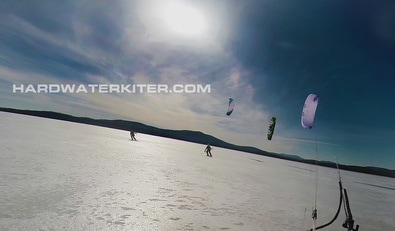 Closed cell foils
Closed cell foils
The great Foils vs. Leading Edge Inflatable (LEI) "debate".
There has been a long standing debate for about which kite is "better" for a given use. In this case snow kiting. Its a ridiculous debate and one that we refuse to participate in but we feel, given the abundance of opinions out there based on a lack of experience we feel that some clarity is in order
.
The reality is that any kite that can generate power and pull you, can be used for snow kiting. What makes one kite or type better for snow kiting basically comes down to the type of riding you plan to do and where. For example if you are more of recreational kiter and don't venture far from your launch pretty much any kite will work. If you are doing longer (50-100 mile) self supported tours your choice of kite (and other equipment) becomes more critical.
Most of our clients, students and local riders choose foils as their kite of choice because they are primarily kite skiing and only occasionally ride water. While many kiters who ride water primarily will ride their LEIs.
And although some companies market certain kites as "Snow kites" there is rarely anything more to it than marketing and these kites can be utilized on snow, dirt, grass or pavement and even water. However the majority of kites marketed as "Snow kites" are simply foil kites used for snow, buggy, kite ground boarding or anything else you need a wind driven engine for.
There are a lot of opinions about which type is best. Take a look at what others are flying in your area and find out why they chose the kites they use. And when it comes to "this kite is best" opinions, take those opinions with a grain of salt as many opinions are based on conjecture, not actual experience and most people who swear by brand "XYZ" or design "ABC" do so because it's the only kite they know. "Fanboys" are not always a reliable impartial source of info.
At HARDWATER KITING we are not interested in the whole "LEI vs. Foil" debate. For the type of riding we do (primarily high speed/ long distance touring) foils are simply the best tool for the job. Like LEI's are generally the best tool use for water use in most conditions.
There has been a long standing debate for about which kite is "better" for a given use. In this case snow kiting. Its a ridiculous debate and one that we refuse to participate in but we feel, given the abundance of opinions out there based on a lack of experience we feel that some clarity is in order
.
The reality is that any kite that can generate power and pull you, can be used for snow kiting. What makes one kite or type better for snow kiting basically comes down to the type of riding you plan to do and where. For example if you are more of recreational kiter and don't venture far from your launch pretty much any kite will work. If you are doing longer (50-100 mile) self supported tours your choice of kite (and other equipment) becomes more critical.
Most of our clients, students and local riders choose foils as their kite of choice because they are primarily kite skiing and only occasionally ride water. While many kiters who ride water primarily will ride their LEIs.
And although some companies market certain kites as "Snow kites" there is rarely anything more to it than marketing and these kites can be utilized on snow, dirt, grass or pavement and even water. However the majority of kites marketed as "Snow kites" are simply foil kites used for snow, buggy, kite ground boarding or anything else you need a wind driven engine for.
There are a lot of opinions about which type is best. Take a look at what others are flying in your area and find out why they chose the kites they use. And when it comes to "this kite is best" opinions, take those opinions with a grain of salt as many opinions are based on conjecture, not actual experience and most people who swear by brand "XYZ" or design "ABC" do so because it's the only kite they know. "Fanboys" are not always a reliable impartial source of info.
At HARDWATER KITING we are not interested in the whole "LEI vs. Foil" debate. For the type of riding we do (primarily high speed/ long distance touring) foils are simply the best tool for the job. Like LEI's are generally the best tool use for water use in most conditions.
